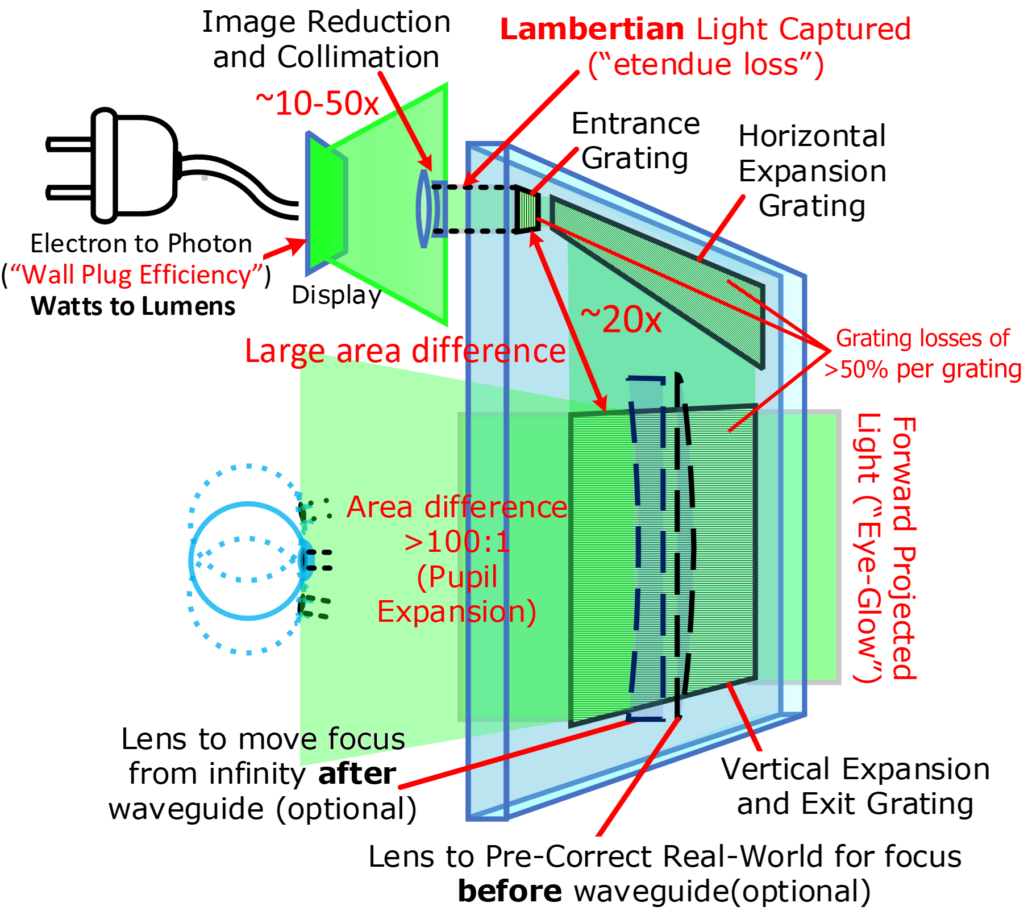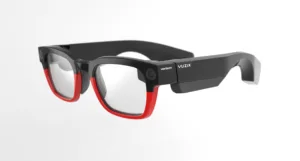MicroLED displays are often hailed as the future of display technology, boasting the ability to output millions of nits of brightness. While this may appear excessive for outdoor use, the physics of waveguides result in only a fraction of the light reaching the eye. To tackle this issue, micro-optics like micro-lens arrays (MLA) are employed to semi-collimate the light and increase nits, but the amount this can help is limited as a function of the pixel pitch and size of the LED light emitting area.
Though diffractive waveguides are popular in MicroLED prototypes, reflective waveguides are more efficient, resulting in brighter and more power-efficient displays. Companies like Lumus claim that their 2D reflective waveguides typically have a 9 times larger entrance area, with their semi-reflective facets losing less light compared to diffraction gratings. PlayNitride also showcased their MicroLEDs using Lumus 2D and older 1D reflective waveguides.
Major AR companies, such as Apple, Meta (formerly Facebook), Google, Snap, and Vuzix, have invested in or secured exclusive deals with at least one MicroLED startup. However, Microsoft has yet to purchase a MicroLED company. On the other hand, Microsoft’s patent application US 2020/0271932 A1, titled “Eyewear With Spectrally Selective Waveguide,” shows a way of combining separate monochrome red, green, and blue MicroLEDs spatially with three inputs. This approach is conceptually like Meta/Facebook’s patent application US 2019/0227318 which I have discussed on my blog.

The question remains whether the excitement and investment surrounding MicroLED technology are justified or simply a result of the “grass being greener” with this relatively new display technology. While the “millions of nits” output has generated headlines, concerns persist regarding manufacturability, full-color production, and, most importantly, power efficiency. Although MicroLEDs show promise, there are pros and cons to using them in AR.
Jade Bird Display (JBD) is currently the only company known to be shipping MicroLEDs in production, and their 640×480 green-only MicroLEDs are used in all working headsets announced to date, including those from Vuzix, Oppo, and WaveOptics (prior to being acquired by Snap). JBD is reportedly developing devices with higher pixel depth and resolution and has sampled some devices. Presently, JBD’s green MicroLEDs support only 4 bits per pixel or 16 (24) brightness levels, which can lead to contour lines in smooth shaded areas. JDB has announce a new ASIC controller that will support more levels.
While there have been continuous improvements in pixel-to-pixel brightness differences and variance in brightness across a device, there is still a visible “grain” remains in what should be a solid area and variances in uniformity. These uniformity issues will become even more apparent with full-color implementation as brightness variations in one color will turn into color shifting.
Perhaps the biggest issue for high volume applications is the roadmap to having full color devices. Using three monochrome MicroLEDs combined with a color X-Cube or combined spatially with waveguides is seen as a stopgap approach. Spatially putting red, green, and blue emitters side by side, as is done with larger displays, will result in a pixel size that is too big too support high resolution in an AR headset form factor. Companies such as Porotech, Ostendo, and Innovation Semiconductor are developing single MicroLED emitters that can produce the full color gamut, but these are still many years away from being commercially available with the uniformity and image quality people have come to expect from display devices.
Other optical designs, such as Bird Bath, Freeform, and VR-pancake optics, are likely to continue using Micro-OLEDs or LCDs for the foreseeable future. This is because, despite being much brighter than Micro-OLEDs, MicroLEDs are still years away from having comparable color control and uniformity. In contrast, Micro-OLEDs are anticipated to continue getting brighter, with some experts claiming roadmaps reaching up to about 30K nits.
Karl Guttag is a named inventor on 150 issued US Patents including key patents related to display devices, graphics/ imaging processors, graphics interface circuits, microprocessors, signal processing (DSP), Synchronous DRAMs, and video/graphics DRAM. Since 2011, his blog, KGOnTech (www.kguttag.com), has analyzed consumer display devices and systems.

